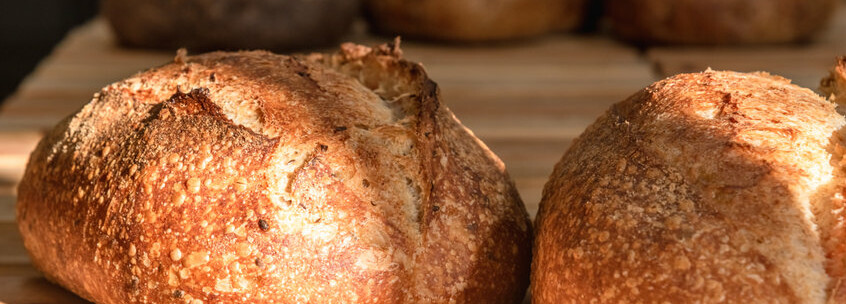
Health-conscious consumers define clean label products as products containing recognizable natural ingredients. These products are expected to be minimally processed and free of chemical ingredients such as emulsifiers, preservatives, artificial flavors and colors, among others.
Chemical emulsifiers are generally used in baking to provide dough strength, by improving dough gas retention and final loaf volume, and/or to provide a softer and finer crumb structure. Common chemical emulsifying solutions include diacetyl tartaric acid ester of mono- and diglycerides (DATEM), ethoxylated monoglycerides (EMG), calcium stearoyl-2-lactylate (CSL), sodium stearoyl-2-lactylate (SSL), polysorbate, and distilled or hydrated monoglycerides. These can be used individually or in combination to achieve both strengthening and softening effects. Bakeries wanting to use clean-label emulsifiers can turn to enzyme-based solutions. As a bonus, reformulating with enzymes may even reduce cost and improve bread quality.
What are enzymes and how do they work?
Enzymes are protein-based molecules naturally obtained by extraction from living organisms (plants, animals, bacteria, and fungi). They are composed of a long chain of amino acid which form a tridimensional structure conformation. They are used in many industrial applications where specific biochemical catalytic reactions are required. In baking they are used primarily for dough strengthening and crumb softness (anti-staling) while replacing chemical functional baking ingredients.
Enzymes’ specific actions can be explained using a lock and key analogy; the lock is the enzyme and the key is the substrate (molecule for which the enzyme has affinity and specificity). Only the matching key fits into the keyhole. In the presence of its substrate, enzymes will specifically either build up, break down, or modify the substrate very quickly into new molecules.
Clean label baking trend
Consumers demand healthier products with a simple and short ingredient list consisting of natural and recognizable ingredients. Additionally, the products should not contain extensively processed ingredients. Around 56% of the consumers look for clean label products as they are thought to be more natural.1 The sales of natural bread and baking goods saw an overall growth of 11.3% in 2019-2020.2
According to Innova 2020 Market Insights, one of the top ten tend involves “tapping into texture as consumers are increasingly recognizing the influence of texture on food…, allowing a heightened sensory experience and often a greater feeling of indulgence.’’ Product developers and bakers that strive to offer consumers with products “giving a more interesting eating experience’’ will also need natural ingredient alternatives with consistent functionality. The label can be cleaned by:
- Ingredient based solutions
- Equipment based solutions
What is the role of emulsifiers?
Emulsifiers in ingredients that can play various functional roles in baking. Their advantages include:
- A superior dough stabilization
- Dough strengthening
- Better dough tolerance and machinability
- Higher product volume
- Better sliceability with fewer crumbs
- Reducing the rate of staling (improving shelf-life)
Common emulsifiers include DATEM, mono- and diglycerides, and SSL. However, nowadays these are typically excluded from a clean label formulation.
Using enzymes to replace emulsifiers
Yes, enzymes can be used to replace the functionalities of emulsifiers, but the choice of enzyme will depend on the substrate available in your formulation and the desired effect. For example:
- Amylase can be used to replace mono- and diglycerides: the enzyme interacts with wheat damaged starch to retard amylopectin crystallization (causing staling) by hydrolyzing/breaking down starch into dextrins and sugars.
- Lipase can be used to replace DATEM: the enzyme uses the wheat flour lipids (polar lipids: phospholipids, glycolipids and triglycerides) to generate molecules with emulsifying properties which can interact with the gluten proteins to strengthen the gluten network and improve gas retention.
Depending on the bread formulation and the ingredient that needs to be replaced, enzymes can be added in formulations as single enzymes or as enzyme combinations to get additional effects or to create synergies between enzymes. They can provide similar functions as chemical emulsifiers such as DATEM, while being a natural and clean label ingredient.
The enzyme optimum activity is dependent on the amount of naturally available substrate that is present in the bread formula, whether it is the flour components (proteins, starches, lipids, fibers, etc.) or it could be other added functional baking ingredients such as lecithin. At the opposite, the level of chemical baking ingredients is not limited as such, except by regulations. When using these types of ingredients, it is therefore possible to add functional molecules at levels higher than what may be required.
References
- https://www.foodbeverageinsider.com/bakery/covid-19-driving-clean-label-bakery-market
- Bizzozero, J. Bakery sales rise on consumer demand for nostalgia. Food Beverage Insider 2020, 1, 4.

